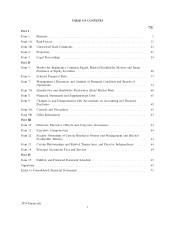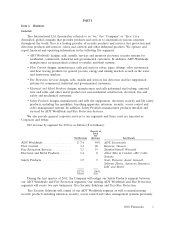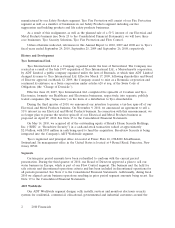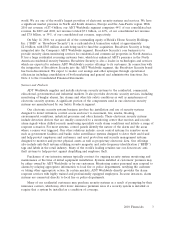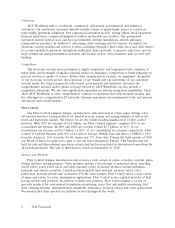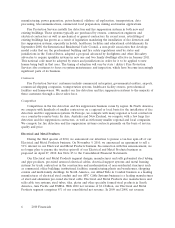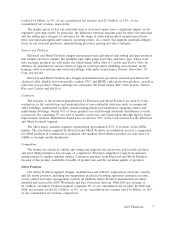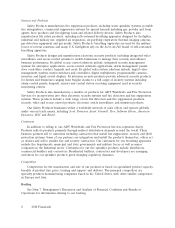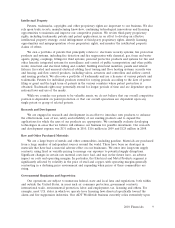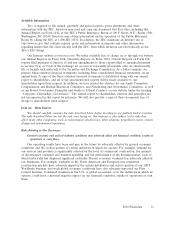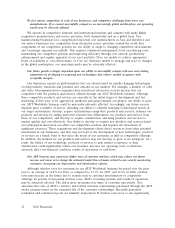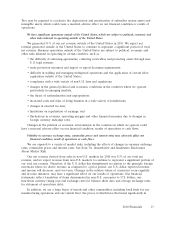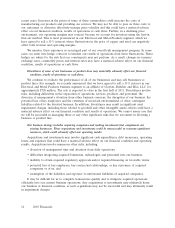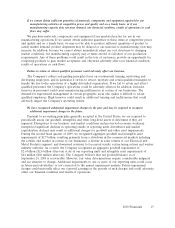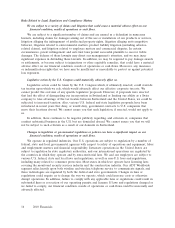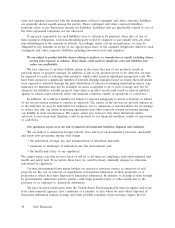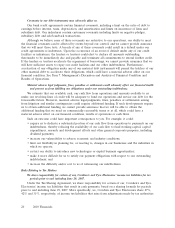ADT 2010 Annual Report Download - page 98
Download and view the complete annual report
Please find page 98 of the 2010 ADT annual report below. You can navigate through the pages in the report by either clicking on the pages listed below, or by using the keyword search tool below to find specific information within the annual report.the use of wireline and wireless telephone service to communicate signals, and wireline and wireless
telephone companies in the United States are regulated by the federal and state governments. Another
example is our Flow Control business, which is subject to strict regulations governing the import and
export of goods and technologies across international borders, particularly with respect to ‘‘dual use’’
products, which are products that may have both civil and military applications or may otherwise be
involved in weapons proliferation. In addition, government regulation of fire safety codes can impact
our Fire Protection Services business. These and other laws and regulations impact the manner in
which we conduct our business, and changes in legislation or government policies can affect our
worldwide operations, both positively and negatively. For a more detailed description of the various
laws and regulations that affect our business, see Item 1A. Risk Factors—Risks Related to Legal,
Regulatory and Compliance Matters and Item 3. Legal Proceedings.
Environmental Matters
We are subject to numerous foreign, federal, state and local environmental protection and health
and safety laws governing, among other things, the generation, storage, use and transportation of
hazardous materials; emissions or discharges of substances into the environment; and the health and
safety of our employees.
Certain environmental laws assess liability on current or previous owners or operators of real
property for the cost of removal or remediation of hazardous substances at their properties or at
properties at which they have disposed of hazardous substances. In addition to cleanup actions brought
by governmental authorities, private parties could bring personal injury or other claims due to the
presence of, or exposure to, hazardous substances or pursuant to indemnifications provided by us in
connection with asset disposals. We have received notification from the U.S. Environmental Protection
Agency and from state environmental agencies that conditions at a number of sites where we and
others disposed of hazardous substances require cleanup and other possible remedial action and may
require that we reimburse the government or otherwise pay for the cost of cleanup of those sites and/or
for natural resource damages. We have projects underway at a number of current and former
manufacturing facilities to investigate and remediate environmental contamination resulting from past
operations.
Given uncertainties regarding the extent of the required cleanup, the interpretation of applicable
laws and regulations and alternative cleanup methods, the ultimate cost of cleanup at disposal sites and
manufacturing facilities is difficult to predict. Based upon our experience, current information regarding
known contingencies and applicable laws, we concluded that it is probable that we would incur
remedial costs in the range of approximately $27 million to $85 million. As of September 24, 2010, we
concluded that the best estimate within this range is approximately $34 million, of which $18 million is
included in accrued and other current liabilities and $16 million is included in other liabilities in the
Consolidated Balance Sheet. In view of our financial position and reserves for environmental matters,
we believe that any potential payment of such estimated amounts will not have a material adverse
effect on our financial position, results of operations or cash flows.
Employees
As of September 24, 2010, we employed approximately 108,000 people worldwide, of which
approximately 41,000 are employed in the United States and 67,000 are outside the United States.
Approximately 29,000 employees are covered by collective bargaining agreements or works councils and
we believe that our relations with the labor unions are generally good.
10 2010 Financials


